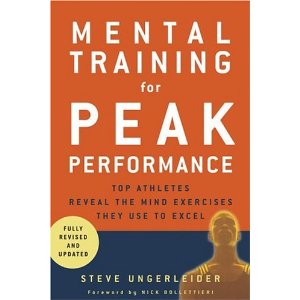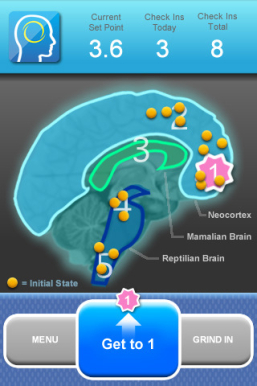Does Inner Voice Improve Cognitive Performance?
 We all have an inner voice. In fact, we talk to ourselves silently throughout the day. Our inner voice is a big part of our mental life but what role does it play in improving brain function and cognitive performance?
We all have an inner voice. In fact, we talk to ourselves silently throughout the day. Our inner voice is a big part of our mental life but what role does it play in improving brain function and cognitive performance?
Found an interesting new study from the University of Toronto that suggest Inner Voice Plays a Role in Self Control. Here is what they claim:
“Through a series of tests, we found that people acted more impulsively when they couldn’t use their inner voice or talk themselves through the tasks,” says Inzlicht. “Without being able to verbalize messages to themselves, they were not able to exercise the same amount of self control as when they could talk themselves through the process.”
What kind of self talk works best? There has been a lot written on avoiding negative self talk especially if it involves cognitive distortions (e.g. I NEVER do anything right) as well as the power of positive self talk. The interesting thing about the Toronto study is that it did not control for the tone of your inner voice. Common sense suggests keeping neutral or positive and task focused is best.
Like to hear from readers that use inner voice to improve cognitive performance. What do you say and why do you think it works?
Categories: Executive Function, Lifestyle, Manage Emotions, Mental Focus, Training Tags:
A Philosophical Method For Next Level Thinking
On the Next Brain blog we explore specific techniques for improving brain function and cognitive performance. We report on techniques from any field where excellence in thinking, learning, perception, memory, creativity, decision-making and other mental functions are known to take place. For example, consider the field of philosophy. Philosophers are known for their ability to think deeply and clearly about the most complex topics. What can we learn from them to enhance our cognitive performance?
One technique that you can pick up fairly quickly and use nearly every day is call the Toulmin Method. This is a method for analyzing text or verbal statements and abstracting any argument that is being made. Making the claim, reasons and justification for an argument clear is a key step in being able to think analytically about a topic rather than just going with our gut instinct.
Colorado State University has developed an excellent guide to The Toulmin Method. In short and simple language it breaks down the parts to an argument, explains how to see them in everyday circumstances and even provides a worksheet to apply the method.
It should take no more than 45 minutes to work through the site including the student example. You can pick a newspaper story, blog post, memo from work or passage from a book you are reading and try and apply it. Keep using it and you will see how the depth and intellectual clarity you have around key issues and arguments improves. You might even find yourself changing your mind on important matters!
Interested to hear from readers that use the Toulmin Method or any other technique for making arguments explicit and analyzing them.
Categories: Decision Making, Problem Solving, Training Tags: critical thinking
Simple Rituals that Make Time for Deeper Thinking
I often hear from students, readers and clients that they don’t have time to think. Bombarded with requests, overloaded with tasks and trying to adapt to a dynamic and stressful environment leaves no time for deep thinking. When trying to work on bigger tasks that require significant thought they do so for a short time before they get interrupted, start to worry about something else or just slip into brain fog.
Simple rituals are one of the best ways to increase the duration of your mental focus and concentration. The key is to keep it simple and practice it regularly.
 An example is the Pomodoro Technique. To make it work you:
An example is the Pomodoro Technique. To make it work you:
1. Select a task to work on
2. Set a timer for 25 minutes
3. Work on just that task until the timer goes off
4. Rest for 5 minutes
Afterwards you can either stop, go back to step 1 and pick a new task or continue to cycle through the steps on the first task until the work is done.
Pomodoro is Italian for tomato. The person that developed the technique, Francesco Cirillo, is Italian and used a kitchen timer that looked like a tomato. This may seem too simple to work but it does. The timer is critical as it creates the conditions that allow us to escape into the task at hand.
For more information on the Pomodoro technique check out the video on the Lifehacker blog. You can get a free e-book and purchase supporting materials directly from Francesco Cirillo and the Pomodoro team.
Of course there are many other simple rituals that achieve the same thing. Interested to hear from readers about the techniques they use to make time for deep thinking.
Categories: Mental Focus, Training Tags:
Simple Study Skills That Light Up Your Brain!
 A colleague shared an interesting New York Times article, Forget What You Know about Good Study Habits. The core idea:
A colleague shared an interesting New York Times article, Forget What You Know about Good Study Habits. The core idea:
“In recent years, cognitive scientists have shown that a few simple techniques can reliably improve what matters most: how much a student learns from studying. The findings can help anyone, from a fourth grader doing long division to a retiree taking on a new language. But they directly contradict much of the common wisdom about good study habits, and they have not caught on.”
The few simple techniques uncovered by cognitive scientist for improving how we study include:
1. Regularly change or alternate the room or environment you study in.
2. Study or work related but not identical topics or study tasks in one sitting. For example, when learning a language study vocabulary, written translation and speaking all in the same session.
3. Space study sessions out over time rather than cramming. Alternate study with simple physical activities.
4. Prepare and take mock tests yourself before taking actual tests.
Simple yes but not commonly practiced by students or adult learners engaged in systematic study. Yet they are proven to “light up the brain” or improve our learning performance.
Interested to hear from readers about other study techniques they have found effective.
Categories: Child, College Student, Memory and Learning, Older Adult, Training Tags: study skills
Memory Champions Win by Training Not Genetics
 Organized and professionally managed memory contests are growing in popularity worldwide. For example, the United Kingdom Open Memory Championship was just held in August. Many amazing feats were recorded including a mental athlete that was able to memorize a deck of 52 cards in sequence in 80 seconds.
Organized and professionally managed memory contests are growing in popularity worldwide. For example, the United Kingdom Open Memory Championship was just held in August. Many amazing feats were recorded including a mental athlete that was able to memorize a deck of 52 cards in sequence in 80 seconds.
The World Memory Sports Council captures data on competitions, memory events and records. Events range from memorizing the order of cards to historic dates and linking names and faces.
To qualify as a grand master of memory you must achieve the memorization of:
- 100 numbers in an hour
- 10 decks of cards in an hour (520 cards)
- One deck in two minutes or under
No easy feat. It is interesting to note that grand masters, record holders and winners in the various national memory championship tend to claim the same thing:
It does not take high IQ or other special mental gifts to be a memory champion. Instead it takes discipline and the willingness to train intensively.
This is great new for readers of the Next Brain Blog. It suggests that systematic training can greatly improve brain function and cognitive performance. It also provides a context to test your brain fitness and compete in a national or international memory championship.
Very interested to hear from readers that participate in the mind sport of memory. What techniques do you use to train? Has this training improved your cognitive performance in everyday life?
Categories: Memory and Learning, Mental Focus, Training Tags: contest
Mental Training Techniques of Top Athletes
Top athletes are not only physically fit but also mentally fit. They use mental training routines just as they use physical training routines. Fortunately, many if not all of their mental training routines can be used to improve brain function or enhance cognitive performance in non-sports related contexts.
 A great resource for exploring these techniques is Steven Ungerleider’s book, Mental Training for Peak Performance. He offers an introduction to mental training and then covers specific techniques including affirmations, self-talk, breathing, mediation, mental snapshots, guided-imagery, visual rehearsal and even dreams. We have covered many of these techniques in the Next Brain blog, but Dr. Ungerleider brings refinements and deeper insights to nearly all of them.
A great resource for exploring these techniques is Steven Ungerleider’s book, Mental Training for Peak Performance. He offers an introduction to mental training and then covers specific techniques including affirmations, self-talk, breathing, mediation, mental snapshots, guided-imagery, visual rehearsal and even dreams. We have covered many of these techniques in the Next Brain blog, but Dr. Ungerleider brings refinements and deeper insights to nearly all of them.
Take for example the use of guided-imagery. This is a technique involves forming vivid mental images and controlling them to practice “in your head” and manage anxiety and performance stress. Ungerleider’s approach stresses understanding how the individual experiences the image – sight, hearing, touch and feel. Other approaches I’ve seen assume we experience images with sight only. He has even developed a Sport Imagery Questionnaire (pgs. 56-57) to help you figure out how you experience images. You assess yourself in four different situations – practicing alone, with others, watching a teammate and competing – and rate how you experience images (1-5) in terms visual (what you saw), auditory (what you heard), kinesthetic (what you felt) and mood (how you felt). You use the results to customize routines for generating and controlling vivid imagery.
I completed the questionnaire and was surprised to find that mood played a key role in how I experience mental imagery. I used this to change my approach to guided-imagery with some good results.
Interested to hear from readers about their experience using the mental training techniques inspired by sports.
Categories: Books, Manage Emotions, Memory and Learning, Mental Focus, Perception, Training Tags: sports
Training for a High-Performing Emotional Brain
 Emotions play a key and often dominate role in our brain function and cognitive performance. We create emotions anytime we appraise or make judgments on people, events, ideas or other things. Our ability to spot, understand and manage emotions in ourselves and others correlates more strongly to life success than IQ. So-called emotional intelligence is a cornerstone for high performance learning, decision-making, creativity, collaboration and other mental and social processes. So I am also on the lookout for new science-based techniques for training my emotional brain.
Emotions play a key and often dominate role in our brain function and cognitive performance. We create emotions anytime we appraise or make judgments on people, events, ideas or other things. Our ability to spot, understand and manage emotions in ourselves and others correlates more strongly to life success than IQ. So-called emotional intelligence is a cornerstone for high performance learning, decision-making, creativity, collaboration and other mental and social processes. So I am also on the lookout for new science-based techniques for training my emotional brain.
For example, take the work on Emotional Brain Training or EBT. It provides a simple way to assess which of five core brain states you are in and then suggests a tool for achieving self-regulation . The five brain states and associated tools are related to your level of stress and include:
- Balanced/reward (joy) state use the Sanctuary tool
- Balanced state use the Feelings check tool
- Verge of stress (mixed) state use the Emotional Housecleaning tool
- Stressed (unbalanced) state use the Cycle tool
- Full blown stress (underwhelmed) state use the Damage control tool
To get started right away you can download the Emotional Brain Training iPhone app (shown above) or find the equivalent in the Droid market.
 If you want to understand more of the theory behind how it works check out the new book, Wired for Joy. Or consider some of the training and coaching offerings from the Institute for Health Solutions.
If you want to understand more of the theory behind how it works check out the new book, Wired for Joy. Or consider some of the training and coaching offerings from the Institute for Health Solutions.
I am just learning to use EBT and am interested to hear from readers that have some experience with one or more of the five tools.
Categories: IQ and EQ, Lifestyle, Manage Emotions, Software, Training Tags: emotion, EQ, smart phone
A Sleeping Mind is a Terrible Thing to Waste
 In an earlier post I reported on research that demonstrated dreaming can improve your ability to solve a maze navigation task by a factor of 10. Since then I’ve been on the look out for science-based advice on how you can tune your approach to sleeping to solve problems, accelerate learning and improve creativity.
In an earlier post I reported on research that demonstrated dreaming can improve your ability to solve a maze navigation task by a factor of 10. Since then I’ve been on the look out for science-based advice on how you can tune your approach to sleeping to solve problems, accelerate learning and improve creativity.
The Scientific American just published a story, How Can You Control Your Dreams? that provides very specific advice. Here is a summary of how to problem solve in a dream:
- You must actually dream about it not just sleep on it
- Problems with a visual representation or solution and those that really require thinking outside the box (defy convention wisdom) yield best to dreaming.
- Prime yourself by thinking about the problem before you sleep. If possible hold an image of it in your head.
- If possible, include a diagram, instrument, sheet of music or whatever other artifacts are associated with your work with the problem near your bedside. Nothing mystical here is just deepens the priming effect.
- Wake up slowly, lying in bed and replay or savor your dream. You may only have fragments but focus on emotions you feel and the rest should follow. This is critical. The solution or partial solution may become evident just as you are waking.
If this method is going to work for you it should do so quickly. Try it for a couple of weeks.
The article goes on to discuss techniques for how to dream about specific people, escape nightmares and engage in lucid dreaming or being aware you are dreaming while you are dreaming.
Very interested to hear from readers that use the dreaming mind to improve brain function and enhance cognitive performance.
Categories: Memory and Learning, Sleep, Training Tags:
Music Training Pumps Up Your Brain
 New research from Northwestern University, Taking Music Seriously, confirms that learning to play a musical instrument is a powerful way to improve general brain function and cognitive performance. To quote:
New research from Northwestern University, Taking Music Seriously, confirms that learning to play a musical instrument is a powerful way to improve general brain function and cognitive performance. To quote:
“Now a data-driven review by Northwestern University researchers that will be published July 20 in Nature Reviews Neuroscience pulls together converging research from the scientific literature linking musical training to learning that spills over to skills including language, speech, memory, attention and even vocal emotion. The science covered comes from labs all over the world, from scientists of varying scientific philosophies, using a wide range of research methods.”
 It seems musical training enhances neuroplasticity and primes the brain for improved performance in a variety of communication and learning tasks. These appear to be life-long and life-wide (outside the context of music) effects.
It seems musical training enhances neuroplasticity and primes the brain for improved performance in a variety of communication and learning tasks. These appear to be life-long and life-wide (outside the context of music) effects.
Interested to hear from readers that use musical training for brain fitness and and cognitive enhancement.
Categories: Memory and Learning, Mental Focus, Music and Audio, Training Tags:
14 Research Proven Ways to Improve Creativity
 The PsyBlog recently published a couple of posts outlining 14 techniques with supporting psychological research for being more creative. The posts are:
The PsyBlog recently published a couple of posts outlining 14 techniques with supporting psychological research for being more creative. The posts are:
I won’t repeat the techniques here as they are described and referenced well in the posts. They are worth a read and some experimentation.
I guarantee you will find at least 2 or 3 techniques you have not tried before.
Interested to hear from readers on specific techniques for boosting creativity.
Categories: Problem Solving, Training Tags: creativity

